The good people at the Gowanus Canal Conservancy had approved the mushroom cultivation workshop I had proposed, and we had done a dry run at our own garden a few weeks earlier. As with our dry run at our home garden, sourcing the correct species of logs for the project turned out to be the main bottleneck. The logs have to be of compatible species with the mushroom species that inoculate them, and they also need to be a certain diameter and length. (Here is one mushroom/tree compatibility chart example.)
We talked to several different local arborists and city departments. Basically the larger arborists offered us plenty of prime oak, but the smallest limb they had was as big as I am… anything better suited to our needs they said was like a twig to them—they would chip it on the spot and not save it. City departments also said that they chip all the tree limbs they cut on the spot. The logs also have to be more or less freshly cut—partially rotting logs will be too infected with competing fungi to allow for the new mycelium to have a chance. Eventually we collected enough oak, birch, and linden to be useful raw material for a workshop of up to 30 people.
As with the garden dry run, we used the same suppliers—Fungi Perfecti, who kindly donated plug spawn (thanks PF!) and Mushroompeople for a few other supplies. I had a few notes I had taken from Paul Stamets’ recent lecture in NYC, during which he touched on a wide range of topics. He was wearing this same hat at the lecture– made out of mushroom, of course. I’d highly recommend checking out the lecture, the video of which has been kindly posted by the New School for Social Research where the talk was held on June 17, 2015:
http://www.veralistcenter.org/engage/events/1956/paul-stamets-mushrooms-for-people-and-planet-ancient-allies-for-modern-maladies/
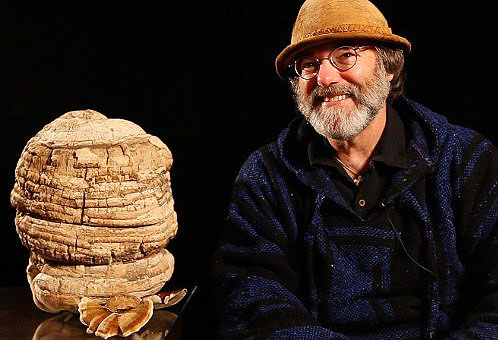
I had read Stamets’ book Mycelium Running, earlier in the year. I wanted to have him sign it at his talk, but incredibly, the line was too long! I recommend this book for any gardener, farmer, or person interested in how ecosystems make the planet work and can improve our environment with a little help.
Here’s Leila, another GCC Volunteer Coordinator and Parks Dept employee, prepping some donated logs for the workshop.
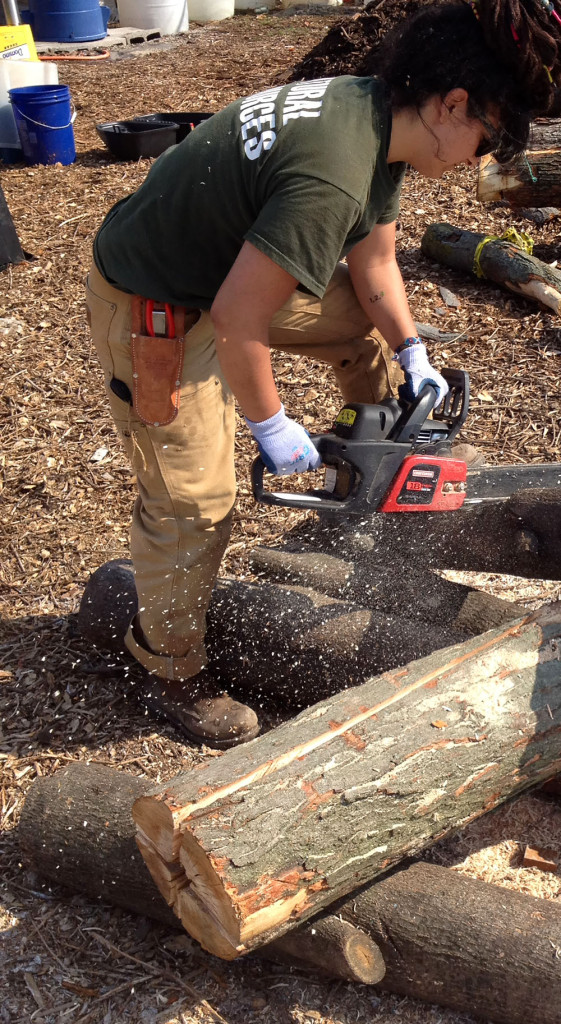
It was supposed to rain that day and I expected a small handful of grumbling soaked stragglers. Instead it was blistering hot and we were over capacity at more than 30 attendees. Turns out we had a little help from a shoutout in Brooklyn Based.
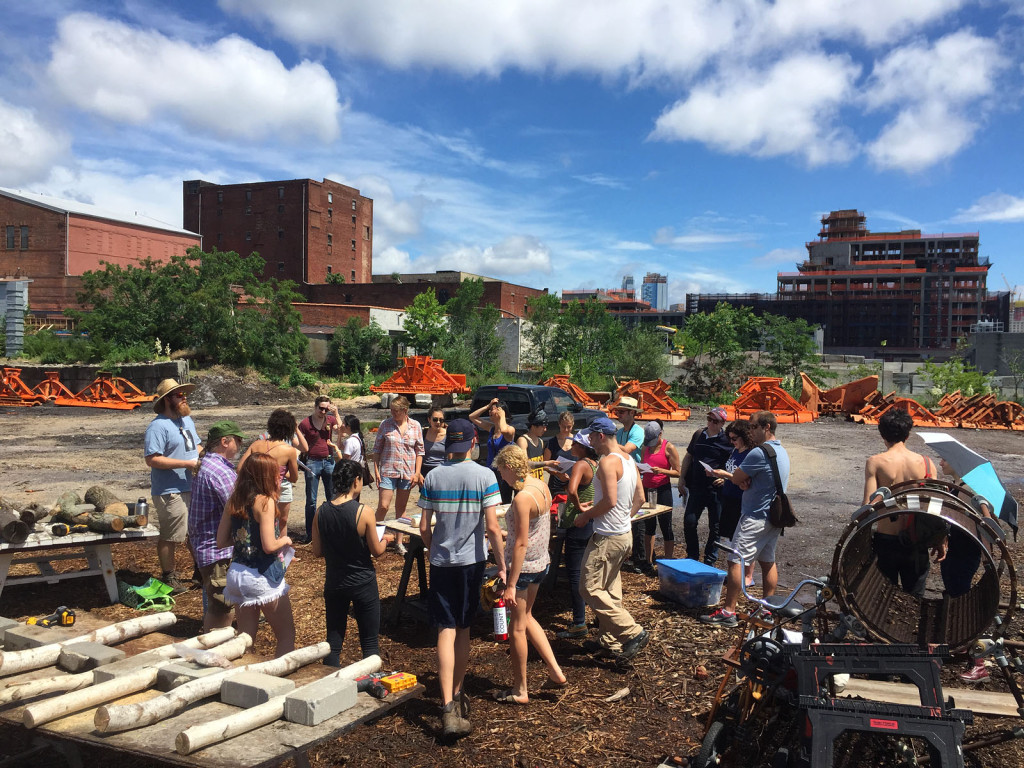
Between the book and the lecture I was able to distill a few points about mushrooms during the workshop that were related to the GCC’s mission of environmental stewardship. The dry run at our home garden had been easy enough and we had worked out any kinks there… except for a chronic shortage of cordless drill batteries at a remote site with no electrical power. No matter, we got it all done. I also strove to be a foil for the group in the photos by setting the bar of my own dresscode as low as possible. But my shoulders paid the price in sunburn—again, it was supposed to rain. Maybe that’s why one couple had an umbrella handy, which they ended up using as a parasol.
Once we got rolling, I reviewed the mushroom life cycle, the role in decomposition that mushrooms play in the ecosystem and in composting (the GCC has a massive composting operation), and mushrooms’ abilities as mycoremediators, meaning that they can break toxic chemicals down into less harmful components, and also uptake pollutants into their tissues (hyperaccumulation), removing it from the soil or substrate. The Gowanus Canal, just beyond the rear fence at this site, is an industrial waterway which has become a federal Superfund site, and which is slowly being cleaned of pollutants which have killed much of the waterway’s ecosystem and leached into local soil as well.
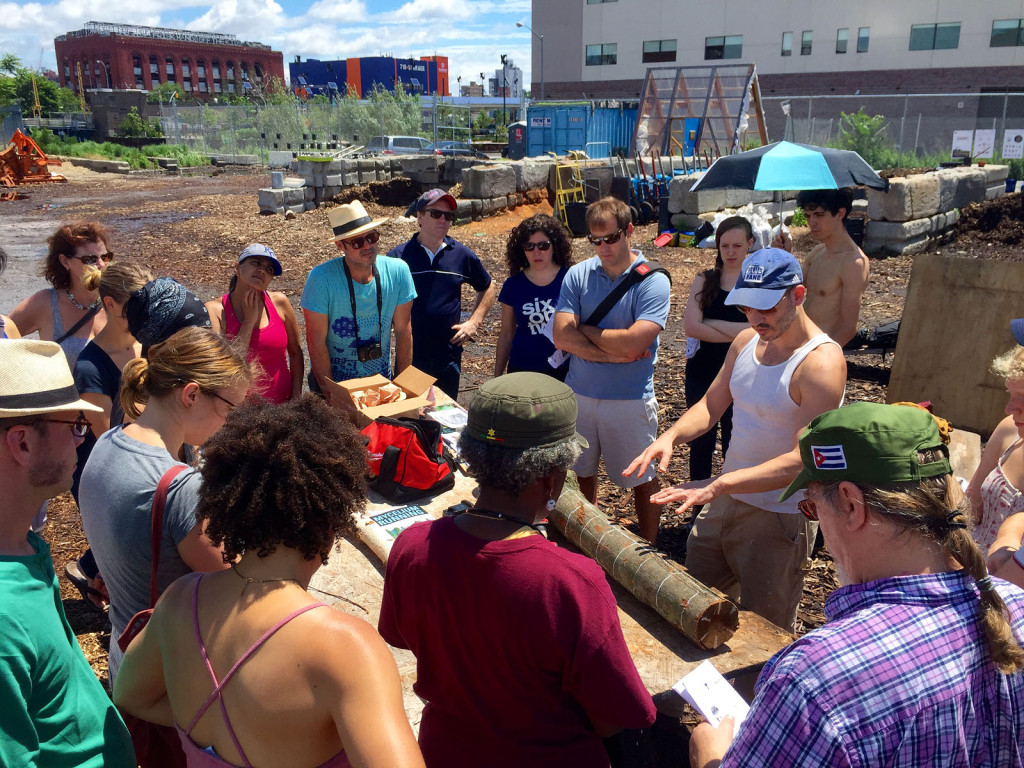
Then, we got down to the business of inoculating logs, just as we had done at home a few weeks before, except on a larger scale. The smell of sawdust and the sound of slowly dying cordless drills filled the air. This is one of my favorite volunteer moves—the choked-up hammer technique. (Who needs that pesky handle?) We used chalk to lay out the different patterns of gridlines on different diameters of wood—this seemed to be a marginally useful added step to the usual process.
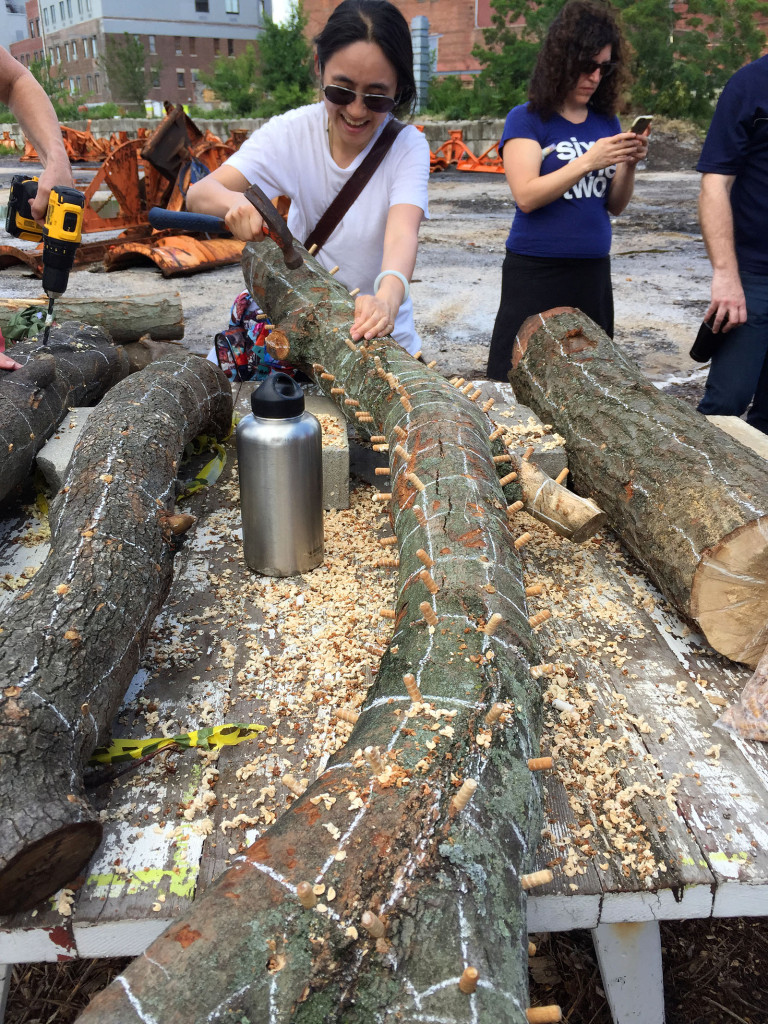
Fun, safe for all ages (there was a little kid or two on hand—actually it happened to be Father’s Day), and holding the potential of edible Shiitake and Oyster mushrooms, it was a good group activity that was also a vehicle for talking about mycelium and mushrooms’ role in our environment. We had enough logs for a few people to take them home if they had a good outdoor spot for them. A common question was: Can we take them home? Yes… if you have a shaded outdoor area. (I dissuaded a few who wanted to leave them under the sink or in a closet. While this might actually yield mushrooms if cared for, the downside would be a possible insect infestation of your apartment from whatever else was living in that log.) We placed a few cinder blocks around to keep the logs from rolling away. Admirable hammering technique here.

The myceium will run through the sap layer of the logs (under the bark) and digest the sugars there. This is why you want relatively fresh logs—there will be fresh sugars remaining for the mycelium to digest. An old log will have much fewer of the nutrients that these type of mushrooms require. At some point, some months later, once the mycelium has propagated through enough of the wood, a seasonal temperature drop and increase in moisture should trigger mushroom growth. I would expect that if the logs do end up producing edible mushrooms, it would be either this fall, next spring, or the fall after that. Fingers crossed… could take years.

The rest of the logs ended up in shady spots in the GCC nursery, protected from the sun and watered regularly along with the nursery plants.
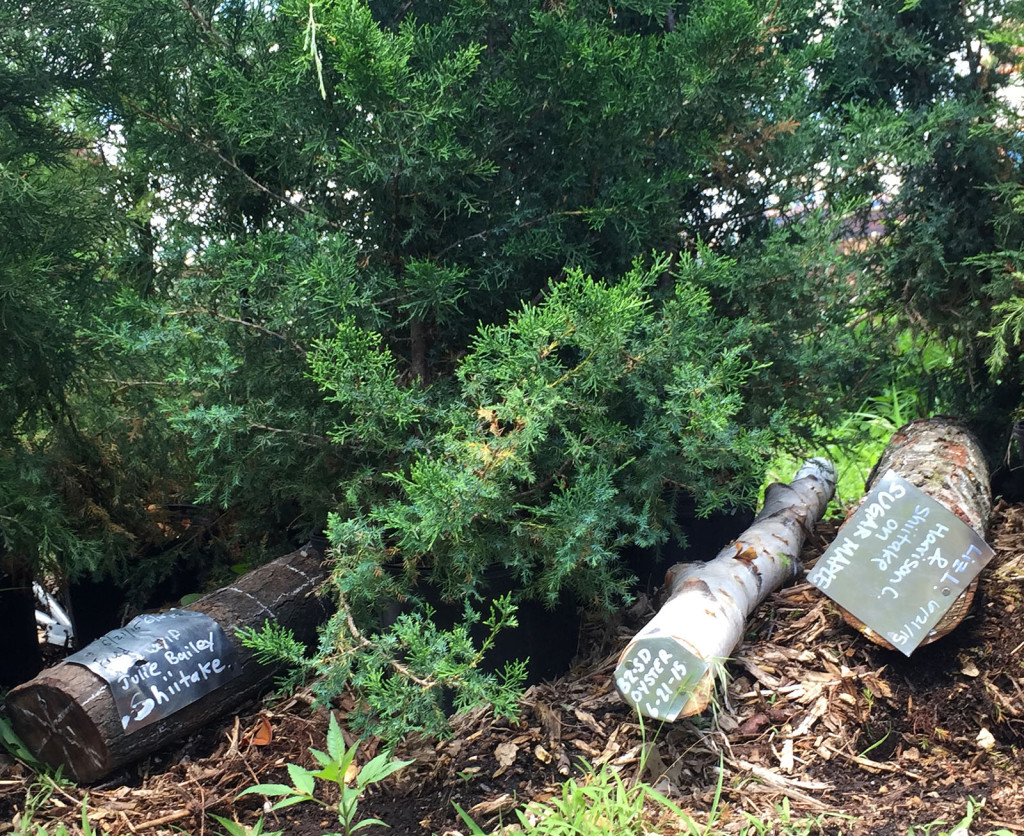
We also were lucky enough to have a huge pile of wood chips handy at the site, so we made the most of them and built a second mushroom growing site apart from the logs: a mushroom ‘raft’ structure. Now, technically you should use hardwood chips. I wasn’t privy to the exact recipe of tree species mixed up in this chip pile, but I know there are a few Christmas trees recycled in there, which are softwood. There are probably more than a few hardwood species as well. But free chips are free chips. The raft consists basically of a few logs on the ground with layers of cardboard and wood chips on top of that. Inoculate that pile with spawn (we had quite a few plug spawn left over, which are fine for this purpose), and keep the whole thing shaded and damp over the summer months, but not soaking wet. Here we are laying down the bed between a couple of conveniently located stacks of cinder blocks.

Here’s the finished mushroom raft. The pallet and burlap bags on the right would form a permeable roof and shade on all sides, allowing rain to fall through and protecting the bed from the summer sun, while allowing for air flow.
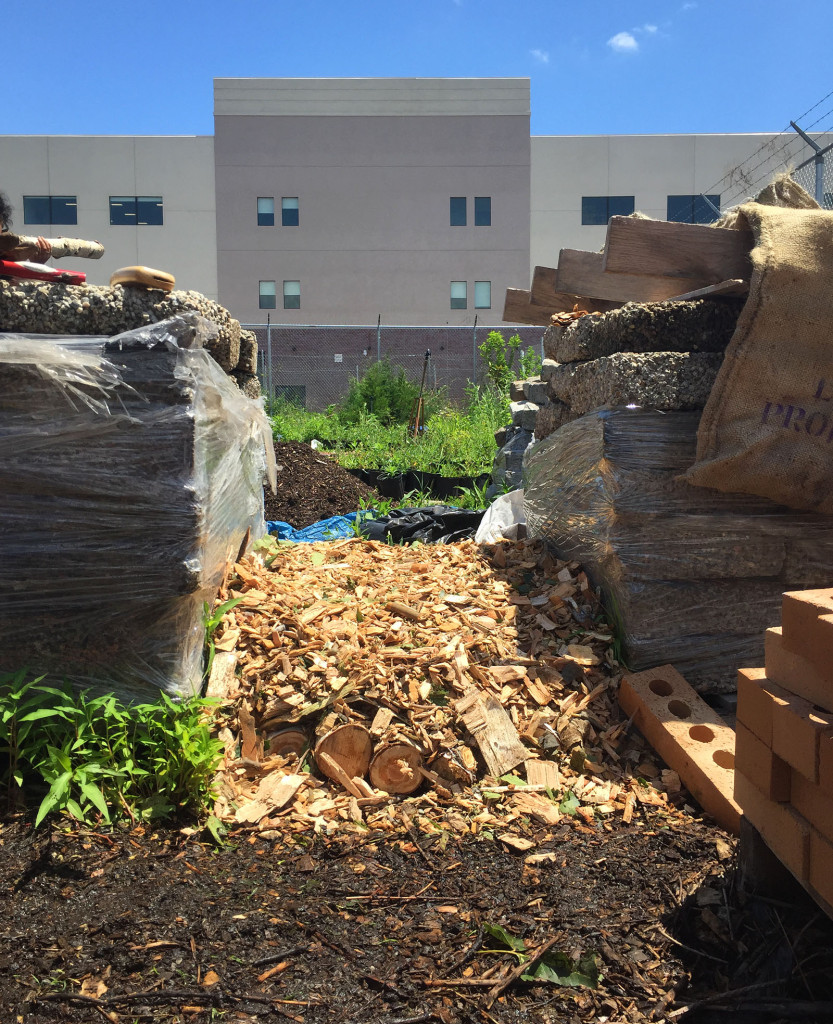
I came back to check on this raft a month later and a month after that. Along with the nursery, it has been getting sprinkled with water by volunteers. The burlap roof keeps it from drying out. Each time I visit, I see that the mycelium appears healthy and is actively running through the substrate material. It may take months, or even years, until mushrooms sprout, if they sprout at all. So far it looks good. Next time, I might try pre-soaking the wood chips in a container for a few days—this may help to reduce competing microbes and give the mycelium and even better chance at being top dog in there.

I’d like to do this workshop again… next time I will have a few more leads on who might be able to supply the right logs. Mushrooms have a certain mystery to them that a lot of us find appealing. Wouldn’t mind throwing a few of them in the skillet, either.
[Many photos by Markella Los]